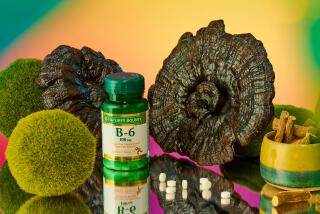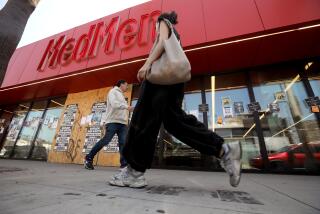Natrol Seeks the Right Elixir to Energize Sales
- Share via
His company’s stock traded last week at less than 20% of its initial offering price. The business just announced a $2.4-million loss for its second quarter. Even boosters agree his industry is in a growth slump. So why does Elliott Balbert look so hopeful and sound so energized?
“We think we can compete,” Balbert, chairman, chief executive and president of Natrol Inc., said in an interview. “We can prevail.”
That’s not a small order. The nutritional supplements industry, of which Natrol is widely considered one of the most reputable and well-organized members, grew at a furious rate in the mid-’90s. That was thanks to the public’s sudden hunger for vitamins, herbal compounds, “all-natural” health and diet aids--any natural remedy, in effect, that could make aging baby boomers feel better and younger.
But a business that lives by trends can die by trends, as supplement companies found out a couple of years ago, when consumer enthusiasm for more and enhanced products began to ebb. Last year, for example, sales of herbal supplements in food, drug and mass merchandiser stores (such as Target and Wal-Mart) declined by 2.6%, according to the Nutrition Business Journal, a trade publication.
Natrol has found its own fortunes buffeted by these same winds of public fickleness. And now, heading into its third decade, the Chatsworth employer of 330 people must find a way to continue to grow amid an industry that’s struggling to regain the elusive consumer popularity that gave it wings in the first place.
Supplement industry sales increased by roughly 15% in 1997 and 9% in 1998, according to the nutrition journal.
Natrol reported year-to-year sales increases of 73% in 1996 and 60% in 1998. Last year, when industry sales grew roughly 6%, Natrol’s sales jumped 20%.
But in the spring and summer, Natrol’s fortunes changed. For the second quarter ended June 30, Natrol reported a loss of $2.4 million, compared with earnings of $1.9 million for the like quarter last year.
The company blamed the loss partly on inventory reductions and shelving reorganizations by retailers. Natrol also wrote down the value of excess inventory produced when its own sales forecasts had been more optimistic.
“To say that this was a disappointing quarter would be an understatement,” Balbert said in a statement accompanying the earnings report.
The company’s stock, which hit a 12-month high of $9.25 in November, closed Monday at $2.31--down 28.85% in the last three months and 71.54% over the past year.
The company expects to return to profitability in the second half of 2000, but Natrol is no stranger to the power of fads. In 1996, Natrol’s fortunes soared, thanks to the sudden popularity of the hormone melatonin, widely touted as a natural sleep aid, and DHEA, promoted as an anti-aging elixir. Together, the pair accounted for roughly half of the company’s sales that year. Then in 1997, the trendy hordes drifted away to new products. That year, the business saw its annual sales inch up by 5%, while its net income dropped by 40%.
Looking back, Balbert sees the experience in mostly positive terms.
“I’ll take opportunities like melatonin and DHEA all the time,” he said. “If someone said to me, I would like to introduce you to a product that does $50 million in sales in one year, then will drop to $7 or $8 million in sales the next, what would I say? Bring it on!”
Earnings from the explosive sales growth of the two products helped Natrol grow as a company. Today, melatonin and DHEA remain two of the business’ most stable products. Still, Balbert acknowledged that the “roller coaster effect” is jarring to those running the company, not to mention Wall Street.
*
Natrol introduced its stock in July 1998 at $15 per share. Since then, the market has driven the price down. Even though Natrol has nearly doubled in size in the last two years, it seems Wall Street remains nervous about a company whose fortunes can swing so wildly based on consumer whims.
This is not an atypical story for the supplement industry. As much as anyone in the field hates to admit it, this is a trend-driven business. One year, melatonin sales drive the fortunes of the industry. Another year, the hot thing is the herb St. John’s wort, and everyone who’s selling it makes a mint.
“In the past, these herbs, these single-supplement herbs, they came into the market and were explosive products that year,” said Patrick Rea, research director for the Nutrition Business Journal.
No one product has shot away from the pack like that this year. But that’s not the only reason why growth rates are down, experts say.
“If you go back five years, the only place you could buy vitamins was a couple of aisles in the back of the drugstore or a major supermarket, or at vitamin stores,” said Scott Van Winkle, an analyst at Adams, Harkness & Hill in Boston. Today, though, vitamins, herbs and a wide variety of other supplements can be found in nearly every sort of retail environment, he said.
In other words, the young industry blossomed, expanded and, finally, matured. Small companies like Natrol became medium-sized companies, and medium and large companies, by and large, got gobbled up by major corporations, as when the Dutch baby food maker Royal Numico acquired U.S.-based General Nutrition Corp. earlier this year. The result is a much more competitive industry, co-existing with a significantly more saturated marketplace.
Industry experts also blame negative reports in the media for the flattening sales of the last two years.
“The media has turned much more skeptical,” Van Winkle said.
And for good reason, said David Schardt, an associate nutritionist specializing in dietary supplements at the Center for Science in the Public Interest, a Washington, D.C.-based nonprofit consumer watchdog group that specializes in food, nutrition and dietary supplement issues.
Schardt cites reports like the one his organization released this month, citing studies finding that St. John’s wort can interfere with other medications that a patient could be taking.
“We’re just finding out now” what side effects some of these previously unstudied herbs may have, he said.
Another problem that consumers face, Schardt said, is that in this unregulated industry, some supplements do not deliver what they promise.
“Some companies are more conscientious than others,” he said. “What you wind up with is a lot of variation.” It’s not that some consumers are getting overdosed with herbs, he said, but that they unknowingly buy inferior products that do not deliver the punch expected. The best bet a consumer can make is to buy a national brand or the store brand at a major chain such as Target or Rite-Aid, Schardt said.
Analysts following the industry say Natrol is one of the more conscientious companies. And Balbert likes to describe how he once rejected “thousands of kilos” of St. John’s wort that didn’t meet his company’s specifications. But he also acknowledges that the plethora of less upright companies taints the entire industry, his own business included.
“Where did that [rejected St. John’s wort] go?” he said. “Somebody bought it. Then the consumer has a non-experience and won’t buy it again.”
*
Perhaps to partly combat the malaise that’s struck the industry and the company itself, Natrol last week announced a reorganizing of company executives--and the hiring of a vice president for marketing. But the best public relations expert of all may be Natrol’s chief executive, who says he remains convinced that more good times are just around the corner.
“I’m extremely bullish on the industry,” Balbert said. The market is driven by aging boomers looking for elixirs to look and feel younger, he said.
“There are more people turning 50 every day this week than ever before,” he said. “There’s this basket of consumer demand that’s getting bigger and bigger, every single day.”
More to Read
Inside the business of entertainment
The Wide Shot brings you news, analysis and insights on everything from streaming wars to production — and what it all means for the future.
You may occasionally receive promotional content from the Los Angeles Times.










